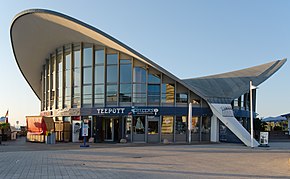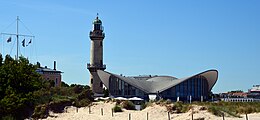Warnemünde tea pot

The Teepott is a sight in the Warnemünde district of Rostock , the roof of which was designed by the civil engineer Ulrich Müther and the restaurant by the architect Erich Kaufmann . The three-storey rotunda was built in 1968 and is a prominent example of Hypar shell architecture. The tea pot is located near the harbor entrance next to the lighthouse on the Warnemünde lake promenade.
construction
Müther's shell buildings not only formed an architectural alternative to the cost-saving panel construction in the GDR, they were also prestige buildings and export hits of the GDR. The Seerestaurant Teepott in Warnemünde, which was completed in 1968 with Erich Kaufmann and Hans Fleischhauer, has been a listed building since 1984 because of its special roof construction.
The roof with a diameter of 30 m consists of three hyperbolic parabolic shells and thus achieves a high level of stability. The shell construction with a total area of approx. 1200 m² is 7 cm thick in the middle and 10 cm thick on the edge. The weight of the roof is held solely by the three inclined reinforced concrete strips. The shear forces of the wind and the horizontal wind pressure are efficiently absorbed due to the roof shape and the low roof weight (15 kg of steel and 0.08 m³ of concrete per square meter), as a calculation carried out by Müther in 2002 and a further review by the TU Dresden in 2005 showed. The two upper floors of the three-story building can be seen from both the promenade and the beach.
gallery
Teepott 1978 with the ferry Kong Frederik IX. ( Gedser-Warnemünde line )
Tea pot and lighthouse from the seaside
history
Tea pavilion
In 1925/1926 the “Teepavillon” restaurant was built on the beach in Warnemünde. The circular building in the style of the New Building was created according to a design by the architect Walter Butzek . The Heidtmann construction company completed the shell by July 4, 1925. After various changes to the plan, including the addition of a terrace on the lake side, the opening was celebrated on June 20, 1926. The first owner of the "tea pavilion" was Adolf Fust. He received a “license to operate the pub” on the condition that he complied with the requirements of the Rostock liquor authority in terms of construction, fire, morals, safety, health and commercial police. Fust initially tried to ensure compliance, but later had to do with the police frequently. Eventually the "tea pavilion" became the property of Rostock lawyer and notary Curt Helm; Fust's wife Margarete leased the restaurant from him in July 1932 for ten years and ran it as a pastry shop, café and dance hall. Since June 1942 employees of the Ernst Heinkel Flugzeugwerke have been housed there. The inventory of the building was gradually divided between different institutions. The building was no longer open to the public. On May 2, 1945, one day after the end of the war in Warnemünde, the "tea pavilion" went up in flames and burned down to the foundation walls. After the war, a kiosk was built on the foundation in the 1950s. Considerations to use the area for other purposes were not implemented.
New construction of the tea pot

In the mid-1960s, the Hanseatic City of Rostock approved the funds needed to rebuild a pavilion on the old foundation. The new building should be based on the contemporary style of the West Berlin congress hall . For this purpose, the civil engineer Ulrich Müther designed the shell construction, the architects Erich Kaufmann, Hans Fleischhauer and Carl-Heinz Pastor from the Rostock housing association developed the design and the architectural design of the restaurant.
In January 1968 the foundation stone was laid for the new construction of the gastronomic facility. The occasion was the 750th anniversary of Rostock. The tea pot was built in just seven months with the support of local construction companies and the shipyard. It was handed over to the Baltic Sea Week in 1968 on June 6th . Over the next few years, the building became one of Warnemünde's landmarks and was included in the city's list of monuments due to its special roof construction.
In September 1985 the tea pot was closed due to an extensive reconstruction. New thermal windows , seating areas and carpets were installed. The 200-seat café received a new ice kitchen, new parquet flooring, floor lamps and chairs. The opening took place on February 28, 1986. Originally it was planned to be used as a café with entertainment, but due to the lack of restaurants in Warnemünde, the building was converted into a restaurant.
After the fall of the Wall , the house was closed. The building went into private ownership, but remained closed. After nine years of vacancy and several failed attempts at privatization and use, another change of ownership took place.
Refurbishment and reopening
The almost 34-year-old building was scaffolded, gutted and then completely renovated in August 2001. By adding many partition walls, the self-supporting roof structure no longer comes into its own. However, Müther accepted this compromise, as this was the only way to preserve the building. The reopening took place on July 19, 2002 by the then Prime Minister Harald Ringstorff and Rostock's then Lord Mayor Arno Pöker and received a lot of public attention. The newly opened shops include a café, a cocktail bar and a specialty restaurant as well as a Maritim store and a Bavarian restaurant. Until 2009, a permanent exhibition by the seafarer Reinhold Kasten was on view in the basement .
New renovation needs in 2018
Friedemann Kunz, the owner of the tea pot and partner in the prefabricated house manufacturer ScanHaus Marlow , commissioned a building report in 2017. In 2018, the investigation revealed that important girders had been severed during the renovation at the turn of the millennium. In addition, metal parts rust, the roof is leaking in several places and power lines are not adequately secured. A full renovation would cost around 20 million euros. Kunz declared himself ready for the renovation, but made it a condition that the previously only leased land would be left to him. In 1996 the Rostock citizenship passed a decision in principle that no urban areas near the banks may be sold. Regardless of this, the construction of an underground car park under the dunes in Warnemünde is also under discussion. Because of the attraction of new traffic, the Warnemünder local advisory board still rejects a dune parking garage.
After a review of the building fabric, the city's monument protection authority determined in 2018 that “the basic structure shows no damage and thus the structural safety for the building is given.” It is mainly a matter of “normal wear and tear”, but one wants keep an eye on developments. A sale of land is therefore out of the question.
Honor
On October 18, 2018, the Federal Chamber of Engineers and the Chamber of Engineers Mecklenburg-Western Pomerania awarded the building a " Historic Landmark of Civil Engineering in Germany ". The Federal Chamber of Engineers has been honoring historically significant engineering structures since 2007, so far 22 German structures have been honored with it.
Origin of name
There are several reasons for the name Teepott . The best known is that the name comes from the vernacular. The tea pavilion stood in the same place as early as 1928 . This got the name Teepott because of its pot shape. The name Teepott is also a little easier to pronounce for the Mecklenburg tongue. The popular name was simply adopted for the new building in 1968.
literature
- Erich Kaufmann and Ulrich Müther : "Teepott" Rostock-Warnemünde. In: Deutsche Architektur , vol. 18, 1969, no. 2, pp. 80–83.
- Andreas Denk: Erich Kaufmann and Ulrich Muether's “Teepott” in Rostock-Warnemuende (1968). In: Deutsche Architektur , 18, H. 3, 1969, S. 157f .; Part 44. Reprinted in: der architekt , issue 10, 1999, p. 14, ISSN 0003-875X .
- Rüdersdorfer Zement GmbH (Ed.): The Teepott Warnemünde. Contrast to the prefabricated building. In: Forum , 2003, no. 2, p. 14 f.
- Ulrich Müther: Bold solitaires. Concrete shell structures in shotcrete. In: DiB-Special / Deutsches IngenieurBlatt , 2005, vol. 12, no . 6, pp. 3–6, source of supply.
- Tanja Seeböck: Examples of renovation. The "tea pot". In: dies .: swings in concrete. Ulrich Müther's shell structures. Thomas Helms Verlag , Schwerin 2016, ISBN 978-3-944033-02-0 , pp. 256-260, 323, table of contents.
- Matthias Ludwig, Johannes Liess / Asko Fromm, Andreas Schätzke, Antje Diebermann: The tea pot in Rostock-Warnemünde. Edited by the Federal Chamber of Engineers. (= Historical landmarks of civil engineering in Germany , vol. 23). Berlin 2018, ISBN 978-3-941867-32-1 .
Movie
- Swing instead of plate - the Hypar bowl in Magdeburg. Documentary, Germany, 2019, 45:12 min., Script and director: André Strobel, production: MDR , series: Der Osten - Discover where you live , first broadcast: May 7, 2019 on MDR television , synopsis by MDR, ( Memento vom May 1, 2019 in the Internet Archive ). In addition to the Hypar bowl and other bowl structures by Müthers, the tea pot is also presented, from 17:36 min. To 22:24 min.
Web links
- Photos: The history of the tea pot in pictures. In: Ostsee-Zeitung , March 30, 2018.
- The Warnemünde tea pot. In: warnemuende-infos.de
- Jürgen Tietz : Swinging beach architecture. In: Neue Zürcher Zeitung , October 8, 2002
- Location map. In: City of Rostock
proof
- ↑ a b c Tanja Seeböck: [data sheet 12] Restaurant »Teepott« Rostock-Warnemünde. In: dies .: swings in concrete. Ulrich Müther's shell structures. Thomas Helms Verlag, Schwerin 2016, ISBN 978-3-944033-02-0 , p. 323.
- ^ Ulrich Müther: Bold solitaires. Concrete shell structures in shotcrete. In: DiB-Special / Deutsches IngenieurBlatt , 2005, p. 5; cited in: Seeböck, 2016, p. 259 f.
- ↑ Andreas Denk: The "Teepott" by Erich Kaufmann and Ulrich Muether in Rostock-Warnemuende (1968). In: Deutsche Architektur , 18, H. 3, 1969, S. 157f .; Part 44. Reprinted in der architekt , issue 10, 1999, p. 14, ISSN 0003-875X .
- ^ Uta von Debschitz: Architecture: Ulrich Müthers Ostseeperlen. In: Spiegel online , September 17, 2003; Takeover of Baltic pearls. ( Memento of October 31, 2007 in the Internet Archive ) In: mare , No. 39, Aug./Sept. 2003, with photos.
- ↑ Ulrich Müther in: You are responsible for the swing. Documentary, 2006.
- ^ Achim Treder: Box collection on the way to the auction. ( Memento from February 12, 2013 in the web archive archive.today ). In: Ostsee-Zeitung , March 5, 2010.
- ↑ a b Andreas Ebel: Teepott: Do tenants have to go out? In: Ostsee-Zeitung , January 17, 2018.
- ^ André Wornowski: Teepott: Will Rostock sell its most valuable property? In: Ostsee-Zeitung , January 17, 2018.
- ^ Maria Pistor: Parking in Warnemünde: Advisory board against the dune underground car park. In: North German Latest News , August 15, 2017.
- ↑ Warnemünde's landmark needs to be renovated. ( Memento from January 18, 2018 in the Internet Archive ). In: NDR , January 17, 2018.
- ^ André Wornowski: City: Teepott is not in danger. In: Ostsee-Zeitung , August 24, 2018.
- ↑ Johanna Hegermann and Axel Büssem: Teepott becomes a historical landmark. In: Ostsee-Zeitung , October 18, 2018.
- ↑ Warnemünde "Teepott" honored as a landmark. In: ndr.de , October 18, 2018.
Coordinates: 54 ° 10 '54.1 " N , 12 ° 5' 8.3" E


